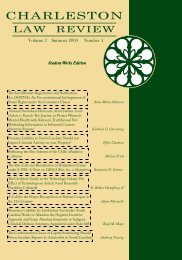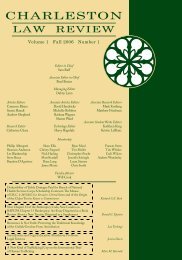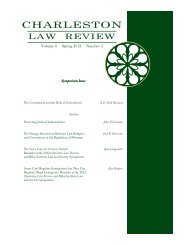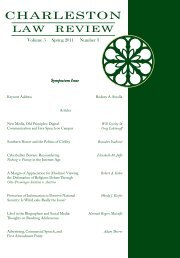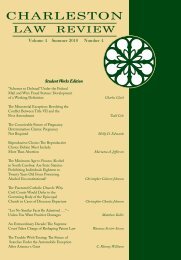Volume 5 Winter 2011 Number 2 - Charleston Law Review
Volume 5 Winter 2011 Number 2 - Charleston Law Review
Volume 5 Winter 2011 Number 2 - Charleston Law Review
Create successful ePaper yourself
Turn your PDF publications into a flip-book with our unique Google optimized e-Paper software.
CHARLESTON LAW REVIEW [<strong>Volume</strong> 5last few years, two comprehensive literature reviews have beenconducted to assess the theoretical and research bases underlyingthe spectrum of learning style theories. And yet, many in legaleducation think of the existence of learning styles as being settledfact. They also think of them rather narrowly—primarily as aquestion of whether one has a visual, auditory, or kinestheticstyle—although many learning style theories exist.This Article explores the controversy surrounding learningstyles and presents the critical bases for the controversy. Itexplains that most disinterested researchers are particularlyskeptical of the “matching hypothesis”—that is, that one mustteach to specific styles. As the first article to address these issuesin the context of legal education, this Article presents a uniqueperspective for those who seek to enhance teaching and learning inlaw schools.I. INTRODUCTIONThe method and curriculum for teaching and learning lawhave been static and unyielding, but small fissures haveappeared in the pedagogical foundations of legal education.Despite an entrenched resistance to change, 1 developments in thepast few years signal that reform may be on the horizon. At thenational level, the Standards <strong>Review</strong> Committee of the AmericanBar Association has been promulgating new standards that focuson learning outcomes assessment measures. 2 At the institutional*Associate Professor of <strong>Law</strong>, Washburn University School of <strong>Law</strong>, Topeka,Kansas. The author thanks Lisa Wolf-Wendel, Ph.D., Professor, Department ofEducational Leadership and Policy Studies, University of Kansas and MichaelHunter Schwartz, Professor, Washburn University School of <strong>Law</strong> for theirreviews of and comments on this article. The author also thanks Nikolas J.Stavropoulos for his able research assistance.1. See WILLIAM M. SULLIVAN ET AL., EDUCATING LAWYERS: PREPARATIONFOR THE PROFESSION OF LAW 18–20, 47–59 (2007). Legal education has been thesubject of several significant studies and criticism since 1914. “Critiques of thelimitations of the case-dialogue method . . . go back to the early twentiethcentury,” yet it remains the dominant form of legal instruction. Id. at 20.2. Standard 302—Learning Outcomes—is available at the ABA’swebsite. ABA STANDARDS FOR THE APPROVAL OF LAW SCHOOLS 302 (ProposedDraftMay5,2010),http://www.abanet.org/legaled/committees/Standards%20<strong>Review</strong>%20documents/Drafts%20for%20Consideration/Student%20Learning%20Out134



